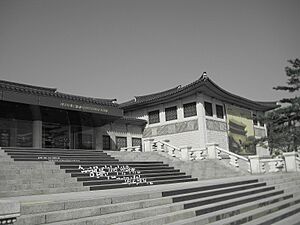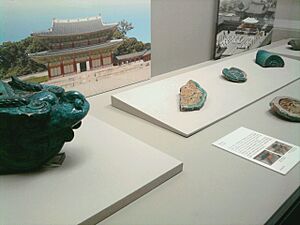National Palace Museum of Korea facts for kids
 |
|
 |
|
| Established | September 1908 |
|---|---|
| Location | Sajikno 34 (Sejongno), Jongno-gu, Seoul, South Korea |
| Visitors | 1,513,000 (2016) |
| Korean name | |
| Hangul |
국립고궁박물관
|
| Hanja |
國立古宮博物館
|
| Revised Romanization | Gungnip gogung bangmulgwan |
| McCune–Reischauer | Kungnip kokung pangmulgwan |
The National Palace Museum of Korea (Korean: 국립고궁박물관) is a special museum. It is located inside Gyeongbokgung Palace in Seoul, South Korea. This museum shows amazing treasures and artifacts from Korea's royal past. It helps us learn about the kings and queens of the Joseon period and the Korean Empire.
Contents
History of the Museum
The museum first opened in September 1908. It was called the "Korean Imperial Museum" back then. It was located in a different palace called Changgyeonggung. In November 1909, the museum welcomed its first visitors.
Later, in April 1938, the Japanese government, which ruled Korea at the time, changed its name. They called it the "Museum of Yi dynasty." After Korea became free in March 1946, the museum was renamed again. It became the "Deoksugung Museum."
In 1991, the Cultural Heritage Administration moved the museum to the Stone Hall of Deoksugung Palace. Then, in 2005, the museum moved to its current modern building. This building is located right inside Gyeongbokgung Palace.
What the Museum Collects
The National Palace Museum of Korea has over 40,000 artifacts. These are royal treasures from the Joseon period and the Korean Empire. Among these, 14 are considered National Treasures of South Korea.
The museum displays many things about the royal family's life. You can see records, learn about state ceremonies, and explore palace architecture. There are also exhibits on royal clothing, daily life, and education. You can even find paintings and music from the dynasty's ruling era.
Special Royal Items
One important item is the royal seal of King Gojong of Joseon. This seal was used for his personal letters to leaders in other countries. It went missing during the time Japan ruled Korea. In 2009, it was found and returned from a Korean collector in the United States.
In March 2021, the museum also opened a special display at Incheon Airport. This display features eight pieces of media art. They show traditional Korean themes and cultural elements to welcome visitors.
Exhibitions to Explore
The museum has many permanent exhibitions. These are always there for you to see.
Permanent Exhibitions
- Royal Symbols and Records
- State Rites
- Joseon Science
- Palace Architecture
- Royal Life
- Royal Childbirth and Education
- Royal Scholarly Culture
- Korean Empire
- Royal Court Paintings
- Royal Court Music
- Royal Palanquins
- Joseon Water Clock
Special Collection of Books
The museum also keeps 1,200 volumes of old historical texts. Among these are 150 copies of Uigwe from the Joseon period. These books were taken in 1922 when Japan ruled Korea. They were returned in December 2011. A special exhibition was held from December 27, 2011, to February 5, 2012, to celebrate their return. These books describe the royal ceremonies of King Gojong of Joseon and King Sunjong of Joseon. They were the last two emperors before Korea was annexed in 1910.
See also
 In Spanish: Museo del palacio nacional de Corea para niños
In Spanish: Museo del palacio nacional de Corea para niños
- List of museums in Seoul
- Gyeongbokgung



